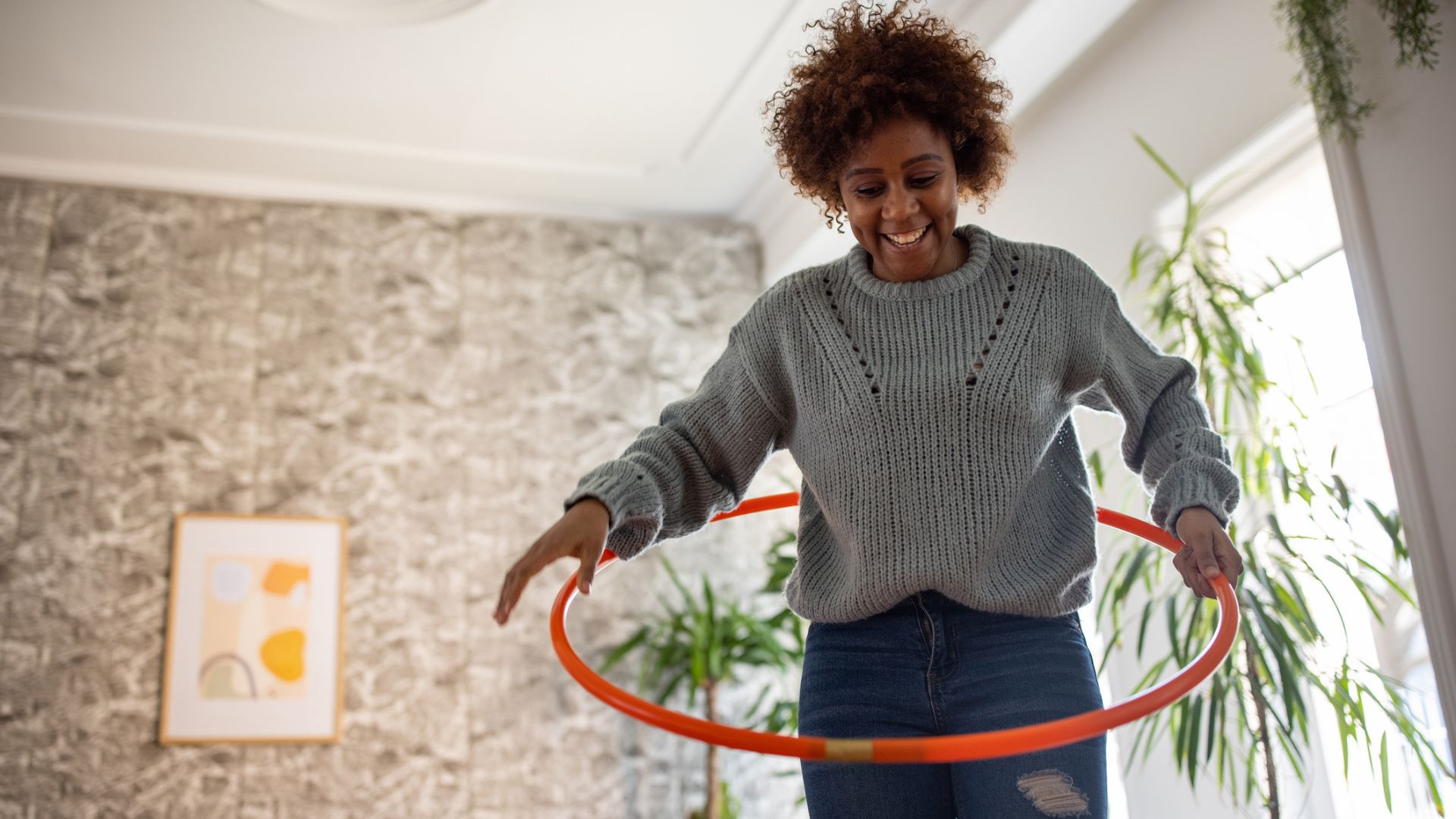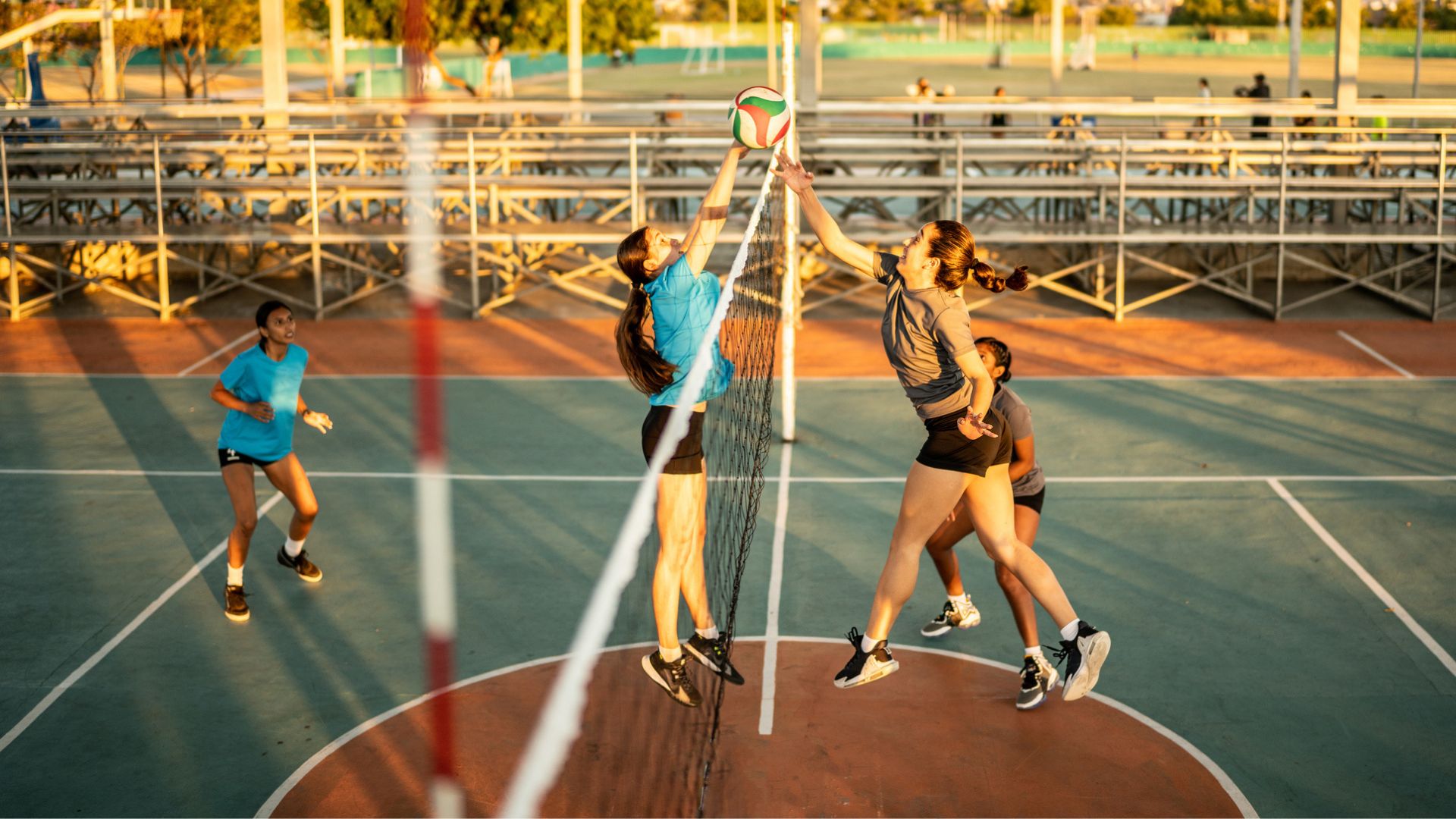
Simple exercises that raise your heart rate and get your blood pumping are some of the best to boost your cardiovascular fitness if you're new to exercise or coming back from injury.
The way to get the most out of these cardio exercises is to find the one you actually enjoy! If you don't like running, that's okay - there are so many other activities you can choose from, whether it's walking every day for 30 minutes, dancing, or skiing, there are so many great ways to incorporate cardio into your routine. And, doing an activity you enjoy versus one you feel like you 'should' do means you'll have a good time while you're doing it and be more likely to keep it up as a habit - and reap the benefits in the long term.
Here, we reveal simple cardio exercises suitable for beginners, the equipment you'll need (if any!) and tips for getting started.
32 beginner-friendly cardio exercises to try
Power walking

Power walking boosts the intensity of a regular stroll. While speed is important, so is form - stand tall with your shoulders back, head upright, and your belly button pulled towards your spine. Small sessions are enough to see a difference in your fitness - 15 to 30 minutes a day.
Swing your arms vigorously at a 90-degree angle to increase your heart rate.
Skipping rope

Skipping is a great cardio workout. You don't need any equipment - apart from the rope - and can do it anywhere you like. So, whether you've only got a few minutes at home to spare or you're on holiday, you can work on your fitness. It can also help boost balance and coordination.
Start with short intervals, increasing them as your get more comfortable.
Boot camp

Bootcamp might not sound like fun but these group workouts, often taking place in local parks and gyms, have a circuit training element to them that can help get your heart rate up and increase cardio exercise.
The workout is good for socialising too, given that you're exercising with others, boosting both mental and physical health. Virtual classes are also easy to find online.
Pilates

Doing a little Pilates every day can make a big difference to your cardiovascular fitness. While Pilates is primarily a strength training exercise, some more dynamic types can help get your heart rate up.
Start with beginner's classes to learn the basics and practice your techniques, focusing on form more than anything.
Stair climbing

Stair climbing is one of the best exercise-snacking ideas if you're looking to work out at home. It's great for building leg strength and muscular endurance in your lower body without committing to a long workout.
You can use the stairs at home, the office, or when you're out and about. Research suggests that just 500 more steps a day can reduce the risk of heart disease by up to 7%.
Swimming

Swimming, whether you swim in an indoor pool or brave the great outdoors with a wild swim, is a full-body workout that's easy on the joints, raises heart rate, and boosts cardiovascular fitness. You don't have to go swimming every day to reap the benefits either - just a swimming workout twice a week can help.
Find a local pool - somewhere convenient to get to - and try different strokes to keep your workouts interesting.
Rowing

Rowing is a high-intensity cardio exercise that boosts cardiovascular fitness in a full-body workout, working multiple muscle groups. To improve your endurance, try doing some intervals - 40 seconds of hard work then 20 seconds of rest, alternating for 5 minutes, building up to 10 minutes as your fitness improves.
Getting out on the water can also help improve mental well-being by giving you the chance to socialise with new people and get some fresh air. However, you can also reap the benefits of rowing at the gym or home with a machine.
Walking

Walking 20 minutes a day is directly linked with a lower risk of hypertension (high blood pressure) - by as much as 29% in some cases, according to research by the University of Oklahoma.
The other benefits of an early morning walk are also endless. It is low impact, can help improve sleep quality and duration, lower stress levels, and boost your mood, offering consistency and a solid routine.
Set yourself a goal to start seeing progress and use one of the best fitness trackers to keep an eye on your step count, pace, distance, and total for each week.
Cycling

Going for a bike ride and doing cycling as a workout are great ways to get your heart rate up and boost your fitness. It's an exercise that works the lower body, improving strength in your quads (thighs) and calves, and it engages the core.
Cycling is also a great way to explore your local area while exercising. However, you can also explore all the benefits of indoor cycling at the gym or at home on a stationary bike.
Elliptical trainer

The elliptical trainer is an excellent alternative to walking and running. It's even more low impact, boosting stamina and cardio in a full-body workout. Although, it also targets specific muscles in the legs - namely the glutes (buttocks) and quadriceps (thighs).
Exercising on the elliptical also burns more calories than other exercises at the gym, making it a great option for those looking to lose weight.
On the elliptical, you can vary the resistance and add to the incline to make your workout harder.
Dance

Dancing is one of the best cardio exercises you can do, burning an equal amount of calories to power walking and running, without the need to even leave the house. In fact, it's best if you stay inside with your favourite music on to do this exercise.
These workouts are energetic and fun and there are so many different types you can try, so experiment - ballet, tap, hip hop, break dancing, jazz, and contemporary dance are all options.
Kickboxing

Kickboxing combines martial arts techniques like kicking and punching for a full-body workout. It can help elevate your heart rate, boost your endurance, and build strength in the upper body - especially the arms and shoulders.
But be sure to warm up before you start and follow online tutorials - or get a certified instructor. Kickboxing is a high-impact sport so it's important to be ready for it.
Yoga

Much like Pilates, doing a little dynamic yoga every day can get your heart rate up and boost your fitness. Styles like Vinyasa, Hatha, and Ashtanga are suitable for increasing heart rate and improving strength and mobility.
Be sure to use a yoga mat for good support under your feet.
Jogging

Jogging is a moderate-intensity activity that can help improve cardiovascular health. While running prioritises speed, jogging is about keeping your heart rate at a steady level. You should be able to keep moving for at least 15 minutes, building up to running for 30 minutes.
Be sure to warm up properly before you head out the door and start slow. To begin with, power walk for five minutes, gradually mixing walking and running together. Try running for one minute, then walking for two.
Circuit training

There are so many benefits of circuit training. These workouts combine strength training with cardio exercise for a full-body workout.
Circuit training uses stations with different exercises - some easy cardio exercises, some bodyweight movements, and some involving kettlebells or dumbbells. You could also incorporate running or cycling drills into your circuit training.
16. Roller blading

Looking for something a little different? Rollerblading has proven health benefits, with research suggesting it can improve speed, balance, and agility. Similar to ice skating, it's a fun and alternative way to stay active.
Find local parks with smooth paths to practice your skills and take friends with you to try the activity together.
Surfing

Surfing is weather and location-dependent but it's another fun way to do cardio exercise in the great outdoors. It's very beneficial for boosting cardio fitness and balance.
There's even evidence to suggest that cold water therapy can help ease perimenopause symptoms.
However, surfing can be a dangerous activity if not done safely. Learn the basics and always go out with a certified, seasoned instructor.
Frisbee

Frisbee is an alternative team sport that can be played competitively, with competitions organised around the country, or casually with friends in the local park. It's budget-friendly as cardio exercises go and can help improve balance, agility, and speed as well.
It also combines other important exercises for boosting cardiovascular health, such as throwing or sprints.
Gardening

Garden has dual benefits for mental and physical health. With planting, digging, and weeding, it can be surprisingly cardio intensive. Whether it's just a small plot of land or a full allotment, even just a couple of sessions outside every week can make a difference.
You can also treat it as a workout by getting your steps in too.
Callisthenics

Callisthenics is a type of strength training that uses body weight as resistance for individual and compound movements. It'll get your heart rate up and there's no need to debate cardio vs strength training when choosing your exercise routine because this workout does both.
You can practice callisthenics at home with a yoga mat for comfort, outside with benches and bars, or at your gym. It's a great exercise for beginners looking to boost cardiovascular fitness as it's all about form and technique, so you can take it one step at a time.
Trampoline

Hopping, jumping jacks, knee jumps, twists - all exercises you can do on a trampoline. It's a fun way to do cardio! Continuously jumping gets your heart rate up, boosting cardiovascular fitness over time and helping improve aerobic capacity.
Although you're jumping, the springy fabric on the trampoline means it's still fairly low impact, so it's a good one if you're dealing with aching joints.
However, always read manufacturer instructions when you're using a trampoline as they can be dangerous.
Boxing

Boxing, whether that's with a bag or shadow boxing, is another excellent cardio workout that raises the heart rate and can help boost cardiovascular fitness and aerobic capacity over time. Plus, it can help improve coordination, balance, and agility, and help to relieve stress.
Start with basic movements and learn the correct form and footwork from a certified instructor or online videos.
Sprints

It will come as no surprise that sprinting, i.e. running very fast, is one of the most effective exercises for boosting cardiovascular fitness. It can help lower blood pressure, resting heart rate, and cholesterol levels, and strengthen the heart muscle - all of which help reduce the risk of long-term health conditions like heart disease.
However, be sure to warm up properly before sprinting as the sudden movement can cause injury.
Weighted walks

Using a weighted vest for walking or a backpack can be a great way to elevate your walking workout or running session. The extra resistance pushes the body, making it harder to do the same exercise you normally would.
It's important to start with light weights, especially if you're new to cardio or strength training, and focus on pace and form.
Skiing

Skiing and snowboarding are two other great cardio exercises, known for boosting endurance and strength with a cardio focus. What's more, you can turn this workout into a holiday in the winter months.
When you first take to the slopes though, be sure to do so with an instructor who can teach you the basics - including how to safely carry your skis, use the lifts, and navigate signs on the mountains.
Aqua aerobics

Don't let the low-impact nature of water aerobics fool you - this is a good workout for those new to exercise or returning from injury and looking to boost their cardiovascular fitness. Here, the water acts as resistance against the muscles, making it slightly harder to complete basic strength training exercises like knee lifts, squat jumps, and incline press-ups.
Find a class at your local swimming pool or try following a workout online to learn the basics and exercise in your own time.
Football drills

Playing football as part of a team has its benefits - from accountability to exercise to socialising away from the pitch - but drills can be just as beneficial for working out on your own. Practice basic skills like dribbling, sprinting, and shooting to get your heart rate up.
It's also one of the easier cardio exercises to get into - all you need is a ball and some open space.
Scootering

Move over cycling - riding a scooter is a great way to work out. Scootering can help boost your heart rate if you do it speedily - safely and in approved areas, of course. It is a single-leg movement though so for balance and coordination, see if you can switch legs and scoot on both.
To improve your fitness, vary your speed and practice skills.
Hula hooping

Hula hooping is one of the easiest cardio exercises you can do from home. Unlike strength training workouts or treadmill sessions, you don't need much equipment or space to do it. Just a simple hula hoop. There are also loads of online videos to help you get started.
When you've progressed past the beginners' stage, why not try using a weighted hula hoop? These intensify the workout, adding extra resistance to your core muscles.
Kettlebell swings

Kettlebell swings are a cardio-strength training hybrid exercise that works multiple muscles in the lower and upper body, as well as the core. While it might not seem very intense, this exercise is a full-body workout that gets your heart rate up very quickly.
It's easy to do at home too with just one heavy kettlebell and enough space to swing. Start light - choose a kettlebell you can comfortably use and work your way up. Focus on your form.
Tennis

Tennis is one of the more traditional cardio exercises for beginners and it's stayed popular thanks to the numerous benefits it can offer both physical and mental health. As well as boosting fitness, balance, coordination, speed, and strength, tennis is a very social sport.
Also, in recent years, other racket sports have grown in popularity - such as pickleball and Padel, so be sure to check these out as well.
Volleyball

Volleyball is typically a summer sport but with indoor courts, you can play year-round. Practice serves and digs on your own or join a local team to reap the mental benefits as well as physical.
When starting out, use a lightweight ball and secure a sandy or cushioned area to practice to lessen the impact of jumping on your joints.







